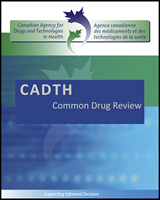You are permitted to make copies of this document for non-commercial purposes, provided it is not modified when reproduced and appropriate credit is given to CADTH. You may not otherwise copy, modify, translate, post on a website, store electronically, republish, or redistribute any material from this document in any form or by any means without the prior written permission of CADTH.
Please contact CADTH’s Vice-President of Corporate Services at ac.htdac@secivresetaroproc with any inquiries about this notice or other legal matters relating to CADTH’s services.
Except where otherwise noted, this work is distributed under the terms of a Creative Commons Attribution-NonCommercial- NoDerivatives 4.0 International licence (CC BY-NC-ND), a copy of which is available at http://creativecommons.org/licenses/by-nc-nd/4.0/

